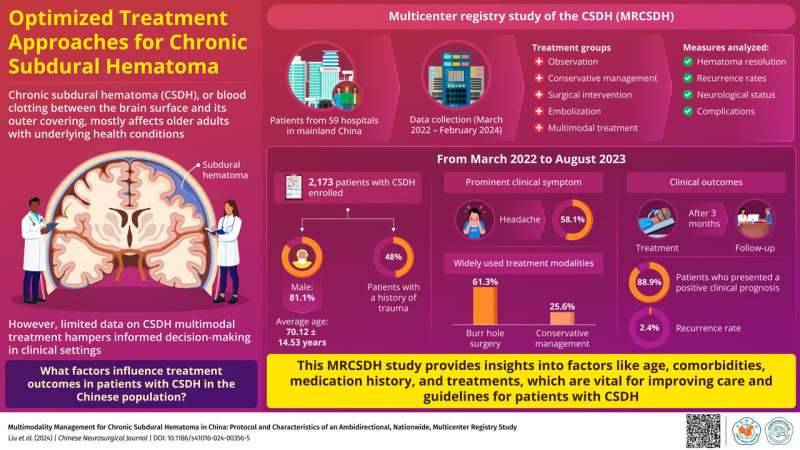We are an affiliate
Newsatw.com is a participant in the Amazon Services LLC Associates Program, an affiliate advertising program designed to provide a means for sites to earn advertising fees by advertising and linking to Amazon.co.uk.“As an Amazon Associate, I earn from qualifying purchases.”


Chronic subdural hematoma (CSDH) is a neurological condition where blood clots between the brain’s surface and its outer covering, causing symptoms like headaches and weakness. Alarmingly, its global incidence and recurrence rates are rising, especially in older adults with health issues.
Surgery remains the primary treatment for CSDH, but there is increasing interest in multimodal approaches like medication, postoperative drainage, and hematoma irrigation. These methods effectively clear acute hematomas and prevent CSDH recurrence. However, limited data hinders clinical decision-making, and many CSDH studies conducted in China suffer from methodological flaws.
To bridge this gap, a team of researchers led by Mr. Tao Liu, Mr. Zhihao Zhao, and Dr. Jinhao Huang from the Department of Neurosurgery, Tianjin Medical University General Hospital and Ministry of Education, Tianjin Neurological Institute, Key Laboratory of Post Neuro-injury Neuro-repair and Regeneration in Central Nervous System, Tianjin Medical University General Hospital, China conducted a nationwide study, called the multicenter registry study of the CSDH (MRCSDH). The study aimed to assess optimal treatment strategies for CSDH in the Chinese population and was conducted from March 2022 to February 2024.
Mr. Liu says, “Through our MRCSDH trial, we can gather robust data to assess the safety and effectiveness of different treatment methods in reducing CSDH recurrence, identify complications, and craft personalized treatment strategies based on individual patient factors.” The study’s findings were published in the Chinese Neurosurgical Journal.
MRCSDH, spanning 59 hospitals in mainland China, documented the traits of the patients with CSDH. A standardized treatment protocol, tailored to each patient’s needs, was developed based on clinical data. Patients underwent follow-ups after 3-, 6-, 12-, and 24-months post-treatment to assess their clinical outcomes.
As of August 2023, 2,173 patients from 59 hospitals participated, with males comprising 81.1% of the total patients. The average age of the patient group was 70.12 years.
Headache was the dominant symptom in over half of the patients. Burr-hole surgery—a classic surgery for CSDH where small holes are made to remove the hematoma—was the primary treatment method, followed by conservative treatment, which consists of rest, pain control, and management of anticoagulant medication use. Surprisingly, 88.9% of the patients presented a favorable prognosis after three months, with a low recurrence rate of 2.4%.
Mr. Liu emphasizes, “Our study gives us valuable real-world data on CSDH treatment, but we must be cautious of biases and data quality issues in interpretation.”
Suffice to say, these findings have the potential to refine the clinical guidelines and, in turn, enhance health care for patients with CSDH.
More information:
Tao Liu et al, Multimodality management for chronic subdural hematoma in China: protocol and characteristics of an ambidirectional, nationwide, multicenter registry study, Chinese Neurosurgical Journal (2024). DOI: 10.1186/s41016-024-00356-5
Provided by
Cactus Communications
Citation:
Optimizing chronic subdural hematoma treatment (2024, April 3)
retrieved 4 April 2024
from https://medicalxpress.com/news/2024-04-optimizing-chronic-subdural-hematoma-treatment.html
This document is subject to copyright. Apart from any fair dealing for the purpose of private study or research, no
part may be reproduced without the written permission. The content is provided for information purposes only.









